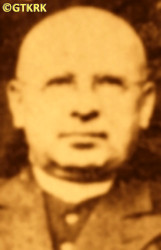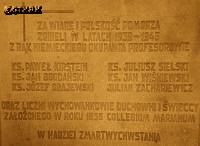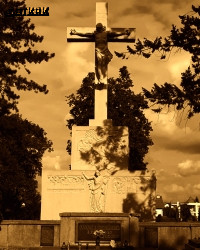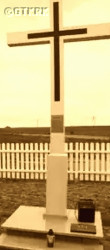Roman Catholic
St Sigismund parish
05-507 Słomczyn
85 Wiślana Str.
Konstancin deanery
Warsaw archdiocese, Poland
full list:
displayClick to display full list

searchClick to search full list by categories
wyświetlKliknij by wyświetlić pełną listę po polsku

szukajKliknij by przeszukać listę wg kategorii po polsku

Martyrology of the clergy — Poland
XX century (1914 – 1989)
personal data
surname
BOGDAŃSKI
forename(s)
John Thomas (pl. Jan Tomasz)
function
diocesan priest
creed
Latin (Roman Catholic) Church RCmore on
en.wikipedia.org
[access: 2014.09.21]
congregation
Society of St Francis de Sales SDBmore on
en.wikipedia.org
[access: 2013.05.19]
(i.e. Salesians of Don Bosco)
diocese / province
Culm (Chełmno) diocesemore on
pl.wikipedia.org
[access: 2012.11.23]
Lublin diocesemore on
pl.wikipedia.org
[access: 2013.05.19]
St Jack Cracow Inspectorate SDB
St Guardian Angels Austro‐Hungarian Inspectorate SDB
date and place
of death
20.10.1939

Wolatoday: Pelplin gm., Tczew pov., Pomerania voiv., Poland
more on
en.wikipedia.org
[access: 2021.12.18]
alt. dates and places
of death
25.10.1939
Szpęgawski foresttoday: Starogard Gdański gm., Starogard Gdański pov., Pomerania voiv., Poland
more on
en.wikipedia.org
[access: 2018.09.23]
details of death
After German and Russian invasion of Poland in 09.1939 and start of the World War II, after start of German occupation, arrested by the Germans on 20.10.1939 in Nowa Cerkiew where was hiding from Germans, who were looking for him — together with the local vicar, Fr Vladislav Białczyk, and the head of the local school.
On the same day taken on a track towards Pelplin.
In a nearby Wola village c. 3 km from Pelplin marched into a field in the middle of forest.
By the bank of a small hill forced to dig a ditch.
Next murdered in a mass execution, together with two other priests, Fr Aloysius Deja and Fr Theodore Borowski.
Murderers immediately covered the ditch with soil.
The murders were prob. carried out by the genocidal Germ. Volksdeutscher Selbstschutz (Eng. Self‐Defense of Ethnic Germans) unit, whose members were Germ. Volksdeutsche (Eng. ethnic Germans), i.e. representatives of the German minority in Poland.
The murder was part of a plan to exterminate the Polish clergy of the Chełmno diocese. I.a., on the same day, 20.10.1939, the Germans murdered most of the cathedral canons and professors of the „Collegium Marianum” gymnasium in Pelplin. They were supposed to be included in this group — Nowa Cerkiew is located c. 8 km from Pelplin — but for some reason they were excluded and murdered separately. The German extermination policy during World War II caused the Chełmno diocese to lose c. 50% of its personnel, and a further 17.5% found themselves outside its territory.
cause of death
mass murder
perpetrators
Germans
sites and events
Szpęgawski forestClick to display the description, «Intelligenzaktion»Click to display the description, Reichsgau Danzig‐WestpreußenClick to display the description, Ribbentrop‐MolotovClick to display the description, Pius XI's encyclicalsClick to display the description
date and place
of birth
01.11.1883

Zegartowicetoday: Papowo Biskupie gm., Chełmno pov., Kuyavia‐Pomerania voiv., Poland
more on
en.wikipedia.org
[access: 2021.12.18]
alt. dates and places
of birth
1885, 1888
Nowa Cerkiewtoday: Morzeszczyn gm., Tczew pov., Pomerania voiv., Poland
more on
en.wikipedia.org
[access: 2021.09.02]
parents
BOGDAŃSKI Martin
🞲 ?, ? — 🕆 ?, ?

TYMIŃSKA Catherine
🞲 ?, ? — 🕆 ?, ?
religious vows
06.01.1909 (permanent)
presbyter (holy orders)
ordination
09.03.1913

Pelplintoday: Pelplin gm., Tczew pov., Pomerania voiv., Poland
more on
en.wikipedia.org
[access: 2021.05.06]
St Barbara RC chapelmore on
pl.wikipedia.org
[access: 2021.12.19] (in Theological Seminary)
positions held
1929 – 1939
professor — Pelplintoday: Pelplin gm., Tczew pov., Pomerania voiv., Poland
more on
en.wikipedia.org
[access: 2021.05.06] ⋄ „Collegium Marianum” gymnasium ⋄ Exaltation of the Holy Cross RC chapel ⋄ Corpus Christi RC parish ⋄ Tczewtoday: Tczew urban gm., Tczew pov., Pomerania voiv., Poland
more on
en.wikipedia.org
[access: 2021.09.02] RC deanery
1935 – 1936
administrator — Bierzgłowotoday: Łubianka gm., Toruń pov., Kuyavia‐Pomerania voiv., Poland
more on
en.wikipedia.org
[access: 2021.05.06] ⋄ Assumption of the Blessed Virgin Mary RC parish ⋄ Bierzgłowotoday: Łubianka gm., Toruń pov., Kuyavia‐Pomerania voiv., Poland
more on
en.wikipedia.org
[access: 2021.05.06] RC deanery
1933 – 1934
professor — Pelplintoday: Pelplin gm., Tczew pov., Pomerania voiv., Poland
more on
en.wikipedia.org
[access: 2021.05.06] ⋄ Theological Seminary — lecturer of Latin language
31.07.1929
incardination in the Culm diocese
1928 – 1929
friar — Congregation's houses, Salesians of Don Bosco SDB — teacher of Educational Institutes ine.g. Aleksandrów Kujawski
1925 – 1928
friar — Sokołów Podlaskitoday: Sokołów Podlaski gm., Sokołów Podlaski pov., Masovia voiv., Poland
more on
en.wikipedia.org
[access: 2021.09.29] ⋄ Society's House, Salesians of Don Bosco SDB — director of Henry Sienkiewicz's Humanities Gymnasium
1922 – 1925
curatus/rector/expositus — Biała Podlaskatoday: Biała Podlaska city pov., Lublin voiv., Poland
more on
en.wikipedia.org
[access: 2021.08.20] ⋄ St Anne the mother of Blessed Virgin Mary RC church ⋄ Nativity of the Blessed Virgin Mary RC parish ⋄ Biała Podlaskatoday: Biała Podlaska city pov., Lublin voiv., Poland
more on
en.wikipedia.org
[access: 2021.08.20] RC deanery — also: prefect at Joseph Ignatius Kraszewski State Gymnasium for Boys
1921 – 1922
prefect — Warsawtoday: Warsaw city pov., Masovia voiv., Poland
more on
en.wikipedia.org
[access: 2021.10.09]
1920
friar — Kielcetoday: Kielce city pov., Holy Cross voiv., Poland
more on
en.wikipedia.org
[access: 2021.06.07] ⋄ Society's House, Salesians of Don Bosco SDB — director of Educational Institute
from 1918
friar — PrzemyślZasanie district
today: Przemyśl city pov., Subcarpathia voiv., Poland
more on
en.wikipedia.org
[access: 2021.04.01] ⋄ Society's House, Salesians of Don Bosco SDB
1917 – 1918
friar — Oświęcimtoday: Oświęcim gm., Oświęcim pov., Lesser Poland voiv., Poland
more on
en.wikipedia.org
[access: 2021.06.07] ⋄ Society's House (Casa Madre), Salesians of Don Bosco SDB — gymnasium counselor (head of a Crafts School)
c. 1913 – 1917
friar — Oświęcimtoday: Oświęcim gm., Oświęcim pov., Lesser Poland voiv., Poland
more on
en.wikipedia.org
[access: 2021.06.07] ⋄ Society's House (Casa Madre), Salesians of Don Bosco SDB — in c. 1911‐1916 assistant and teacher of the 1st grade of gymnasium, 1916‐1917 chief assistant to students (in gymnasium)
till 1913
student — Foglizzo Canavesetoday: Foglizzo, Turin prov., Piedmont reg., Italy
more on
en.wikipedia.org
[access: 2021.12.18] ⋄ theology, Theological Institute (higher theological seminary), Salesians of Don Bosco SDB
from c. 1910
friar — Viennatoday: Vienna state, Austria
more on
en.wikipedia.org
[access: 2020.07.31] ⋄ Society's House, Salesians of Don Bosco SDB — start of theological studies, preparing for the sacrament of priesthood
till c. 1910
pupil — Oświęcimtoday: Oświęcim gm., Oświęcim pov., Lesser Poland voiv., Poland
more on
en.wikipedia.org
[access: 2021.06.07] ⋄ Philosophical Institute (also known as the Philosophical Studentate), Salesians of Don Bosco SDB
pupil — Ivreatoday: Turin prov., Piedmont reg., Italy
more on
en.wikipedia.org
[access: 2022.09.11] ⋄ Society's House, Salesians of Don Bosco SDB — student of the gymnasium, i.e. the Sons of Mary Institute for late vocations
novitiate — Lombriascotoday: Turin prov., Piedmont reg., Italy
more on
en.wikipedia.org
[access: 2022.01.09] ⋄ Society's House, Salesians of Don Bosco SDB
08.01.1901
accession — Ivreatoday: Turin prov., Piedmont reg., Italy
more on
en.wikipedia.org
[access: 2022.09.11] ⋄ Society's House, Salesians of Don Bosco SDB
others related
in death
BOROWSKIClick to display biography Theodore, DEJAClick to display biography Louis, BIAŁCZYKClick to display biography Vladislav
sites and events
descriptions
Szpęgawski forest: In Szpęgawsk forest Germans, as part of their «Intelligenzaktion» — extermination of Polish intelligentsia in Pomerania — between 09.1939 and 01.1940 in mass executions murdered 5,000‐7,000 Poles. Among them were c. 49 Catholic priests — all bar one from Starogard Gdański county, 30 from Culm diocese Curia and 5 from Pelplin. 1,692 psychiatric hospital patients in Kocborowo — in 15 mass executions starting from 22.09.1939 — part of «Aktion T4», i.e. Germ. „Vernichtung von lebensunwertem Leben” (Eng. „elimination of live not worth living”) extermination program, were also murdered there. The victims were brought from Starogard Gdański jail in trucks or buses with windows blackened at sunset or during the night. Transports avoided main roads. At murder site prisoners were forced to kneel at banks of the ditches and murdered by a shot to the back of the head. Wounded were finished off with rifle butts or buried alive. The murders were carried out mainly by the genocidal Germ. Volksdeutscher Selbstschutz (Eng. Self‐Defense of Ethnic Germans) unit, whose members were Germ. Volksdeutsche (Eng. ethnic Germans), i.e. representatives of the German minority in Poland from Starogard Gdański and vicinity, supervised by a c. 12‐strong unit called SS‐Heimwehr Danzig (Eng. SS Home Guard Gdańsk), commanded by a certain SS‐Obersturmführer Wilhelm Fast. The extermination of patients from the psychiatric hospital in Kocborowo was carried out by the SS‐Wachsturmbann „Eimann” unit (Eng. Guard and Assault Unit „Eimann”) established by a decree of the Senate of the Free City of Gdańsk of 03.07.1939, based on the 36th Regiment of the genocidal German «SS» organization, commanded by SS‐Obersturmbannführer Kurt Eimann. After the end of World War II, 39 mass graves were discovered in the Szpęgawski forests. (more on: en.wikipedia.orgClick to attempt to display webpage
[access: 2018.09.23])
«Intelligenzaktion»: German: «Intelligenzaktion» (English: „Intelligence Action”) — a German program of extermination of the Polish elite, mainly the intelligentsia and leadership layers, carried out from the beginning of the occupation in w 09.1939 to 04.1940, mainly in territories directly annexed to Germany, but also in the so‐called Germ. Generalgouvernement (Eng. General Governorate), where it was called «AB‐aktion». In the first phase, immediately after the beginning of the German occupation, during military operations carried out by the Germ. Wehrmacht (Eng. Armed Forces) and the genocidal units of the Germ. Einsatzgruppen (Eng. Operational Groups) of the Germ. Sicherheitspolizei (Eng. Security Police), i.e. SiPo, and Germ. Sicherheitsdienst des Reichsführers SS (Eng. Security Service of the Reichsführer SS), i.e. SD, organized by the Germ. Reichssicherheitshauptamt (Eng. Reich Main Security Office), i.e. RSHA, which followed the troops, carried out under the Germ. Unternehmen „Tannenberg” (Eng. Operation „Tannenberg”) — based on the so‐called Germ. Sonderfahndungsliste (Eng. Special Wanted Lists), i.e. proscription lists of Poles considered particularly dangerous to the Third Reich, prepared by the Zentralstelle II/P (Polen) unit of the German RSHA. Later, implemented by the German civilian occupation authorities and the genocidal unit of the Germ. Volksdeutscher Selbstschutz (Eng. Ethnic Germans Self‐Defense), whose members were Germ. Volksdeutsche (Eng. Ethnic Germans), i.e. representatives of the German minority in Poland. According to various sources, these lists, at the beginning of 09.1939, could have contained the details of 61,000—88,000 „dangerous” Poles — although these figures cannot be confirmed. In total, during this genocide, c. 50,000 teachers, Catholic priests, representatives of the landed gentry, freelancers, social and political activists, and retired military personnel were systematically and methodically murdered. Another 50,000 were sent to concentration camps, where only a negligible percentage survived. (more on: en.wikipedia.orgClick to attempt to display webpage
[access: 2014.10.04])
Reichsgau Danzig‐Westpreußen: After the Polish defeat in the 09.1939 campaign, which was the result of the Ribbentrop‐Molotov Pact and constituted the first stage of World War II, and the beginning of German occupation in part of Poland (in the other, eastern part of Poland, the Russian occupation began), the Germans divided the occupied Polish territory into five main regions (and a few smaller). The largest one was transformed into Germ. Generalgouvernement (Eng. General Governorate), intended exclusively for Poles and Jews and constituting part of the so‐called Germ. Großdeutschland (Eng. Greater Germany). Two were added to existing German provinces. From two other separate new provinces were created. Vistula Pomerania region was one of them, incorporated into Germany on 08.10.1939, by decree of the German leader Adolf Hitler (formally came into force on 26.10.1939), and on 02.11.1939 transformed into the Germ. Reichsgau Danzig‐Westpreußen (Eng. Reich District of Gdańsk‐West Prussia) province, in which the law of the German state was to apply. The main axis of the policy of the new province, the territory of which the Germans recognized as the Germ. „Ursprünglich Deutsche” (Eng. „natively German”), despite the fact that 85% of its inhabitants were Poles, was Germ. „Entpolonisierung” (Eng. „Depolonisation”), i.e. forced Germanization. C. 60,000 Poles were murdered in 1939‐1940, as part of the Germ. „Intelligenzaktion”, i.e. extermination of Polish intelligentsia and ruling classes, in c. 432 places of mass executions — including c. 220 Polish Catholic priests. The same number were sent to German concentration camps, from where few returned (over 300 priests were arrested, of whom c. 130 died in concentration camps). C. 124,000‐170,000 were displaced, including c. 90,000 to the Germ. Generalgouvernement. Poles were forced en masse to sign the German nationality list, the Germ. Deutsche Volksliste DVL. Polish children could only learn in German. It was forbidden to use the Polish language during Catholic Holy Masses and during confession. Polish landed estates were confiscated..To further reduce the number of the Polish population, Poles were sent to forced labor deep inside Germany. The remaining Poles were treated as low‐skilled labor, isolated from the Germans and strictly controlled — legally, three or three of them could only meet together, even in their own apartments. Many were conscripted into the German Wehrmacht army. After the end of hostilities of World War II, the overseer of this province, the Germ. Reichsstatthalter (Eng. Reich Governor) and the Germ. Gauleiter (Eng. district head) of the German National Socialist Party, Albert Maria Forster, was executed. (more on: en.wikipedia.orgClick to attempt to display webpage
[access: 2024.06.24])
Ribbentrop‐Molotov: Genocidal Russian‐German alliance pact between Russian leader Joseph Stalin and German leader Adolf Hitler signed on 23.08.1939 in Moscow by respective foreign ministers, Mr. Vyacheslav Molotov for Russia and Joachim von Ribbentrop for Germany. The pact sanctioned and was the direct cause of joint Russian and German invasion of Poland and the outbreak of the World War II in 09.1939. In a political sense, the pact was an attempt to restore the status quo ante before 1914, with one exception, namely the „commercial” exchange of the so‐called „Kingdom of Poland”, which in 1914 was part of the Russian Empire, fore Eastern Galicia (today's western Ukraine), in 1914 belonging to the Austro‐Hungarian Empire. Galicia, including Lviv, was to be taken over by the Russians, the „Kingdom of Poland” — under the name of the General Governorate — Germany. The resultant „war was one of the greatest calamities and dramas of humanity in history, for two atheistic and anti‐Christian ideologies — national and international socialism — rejected God and His fifth Decalogue commandment: Thou shall not kill!” (Abp Stanislav Gądecki, 01.09.2019). The decisions taken — backed up by the betrayal of the formal allies of Poland, France and Germany, which on 12.09.1939, at a joint conference in Abbeville, decided not to provide aid to attacked Poland and not to take military action against Germany (a clear breach of treaty obligations with Poland) — were on 28.09.1939 slightly altered and made more precise when a treaty on „German‐Russian boundaries and friendship” was agreed by the same murderous signatories. One of its findings was establishment of spheres of influence in Central and Eastern Europe and in consequence IV partition of Poland. In one of its secret annexes agreed, that: „the Signatories will not tolerate on its respective territories any Polish propaganda that affects the territory of the other Side. On their respective territories they will suppress all such propaganda and inform each other of the measures taken to accomplish it”. The agreements resulted in a series of meeting between two genocidal organization representing both sides — German Gestapo and Russian NKVD when coordination of efforts to exterminate Polish intelligentsia and Polish leading classes (in Germany called «Intelligenzaktion», in Russia took the form of Katyń massacres) where discussed. Resulted in deaths of hundreds of thousands of Polish intelligentsia, including thousands of priests presented here, and tens of millions of ordinary people,. The results of this Russian‐German pact lasted till 1989 and are still in evidence even today. (more on: en.wikipedia.orgClick to attempt to display webpage
[access: 2015.09.30])
Pius XI's encyclicals: Facing the creation of two totalitarian systems in Europe, which seemed to compete with each other, though there were more similarities than contradictions between them, Pope Pius XI issued in 03.1937 (within 5 days) two encyclicals. In the „Mit brennender Sorge” (Eng. „With Burning Concern”) published on 14.03.1938, condemned the national socialism prevailing in Germany. The Pope wrote: „Whoever, following the old Germanic‐pre‐Christian beliefs, puts various impersonal fate in the place of a personal God, denies the wisdom of God and Providence […], whoever exalts earthly values: race or nation, or state, or state system, representatives of state power or other fundamental values of human society, […] and makes them the highest standard of all values, including religious ones, and idolizes them, this one […] is far from true faith in God and from a worldview corresponding to such faith”. On 19.03.1937, published „Divini Redemptoris” (Eng. „Divine Redeemer”), in which criticized Russian communism, dialectical materialism and the class struggle theory. The Pope wrote: „Communism deprives man of freedom, and therefore the spiritual basis of all life norms. It deprives the human person of all his dignity and any moral support with which he could resist the onslaught of blind passions […] This is the new gospel that Bolshevik and godless communism preaches as a message of salvation and redemption of humanity”… Pius XI demanded that the established human law be subjected to the natural law of God , recommended the implementation of the ideal of a Christian state and society, and called on Catholics to resist. Two years later, National Socialist Germany and Communist Russia came together and started World War II. (more on: www.vatican.vaClick to attempt to display webpage
[access: 2023.05.28], www.vatican.vaClick to attempt to display webpage
[access: 2023.05.28])
sources
personal:
www.zkp.tczew.plClick to attempt to display webpage
[access: 2012.11.23], www.niedziela.diecezja.torun.plClick to attempt to display webpage
[access: 2013.05.19], parafiabierzglowo.wordpress.comClick to attempt to display webpage
[access: 2023.12.09], informator.pelplin.plClick to attempt to display webpage
[access: 2013.08.31]
bibliographical:
„Biographical dictionary of Chełmno diocese priests consecrated in 1821‐1920”, Fr Henry Mross, Bernardinum Editorial House, Pelplin, 1995
original images:
informator.pelplin.plClick to attempt to display webpage
[access: 2013.08.31], nowa.morzeszczyn.plClick to attempt to display webpage
[access: 2018.02.15]
LETTER to CUSTODIAN/ADMINISTRATOR
If you have an Email client on your communicator/computer — such as Mozilla Thunderbird, Windows Mail or Microsoft Outlook, described at WikipediaPatrz:
en.wikipedia.org, among others — try the link below, please:
LETTER to CUSTODIAN/ADMINISTRATORClick and try to call your own Email client
If however you do not run such a client or the above link is not active please send an email to the Custodian/Administrator using your account — in your customary email/correspondence engine — at the following address:

giving the following as the subject:
MARTYROLOGY: BOGDAŃSKI John Thomas
To return to the biography press below:
 Click to return to biography
Click to return to biography












